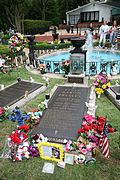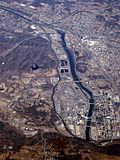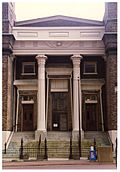List of National Historic Landmarks in Tennessee
Following is a list of sites and structures in
Mississippi. All National Historic Landmarks are listed on the National Register of Historic Places
.
In addition to the National Historic Landmarks, six historic areas in Tennessee that are listed on the National Register are administered by the
National Monument in 1935 and redesignated a National Historic site in 1963; and four Civil War
sites:
- Chickamauga and Chattanooga National Military Park (shared with Georgia), established 1890; the park now includes the Moccasin Bend Archeological District that is separately designated a National Historic Landmark;
- Fort Donelson National Battlefield, established 1928;
- Shiloh National Military Park, established 1894; the Native American mounds in the park are separately designated as a National Historic Landmark; and
- Stones River National Battlefield, established 1927.
Current National Historic Landmarks
| [1] | Landmark name | Image | Date designated[2] | Location | County | Description |
|---|---|---|---|---|---|---|
| 1 | Beale Street Historic District |  |
May 23, 1966 (#66000731) |
Memphis 35°08′22″N 90°03′07″W / 35.1394°N 90.0519°W | Shelby | Birthplace of the African-American music and the music of the United States generally. W.C. Handy was a prominent Beale Street figure from when this was a lively district of saloons and theaters .
|
| 2 | William Blount Mansion |  |
January 12, 1965 (#66000726) |
Knoxville 35°57′40″N 83°54′55″W / 35.9611°N 83.9152°W | Knox | The home of Constitutional Convention where he represented North Carolina, Blount then became governor of the Southwest Territory, led Tennessee to statehood, and later served in the US Senate .
|
| 3 | Chucalissa Site
|
 |
April 19, 1994 (#73001830) |
Memphis 35°03′45″N 90°07′44″W / 35.0625°N 90.1289°W | Shelby | This archaeological mound complex dates from the Walls phase (approximately 15th century) of the Mississippian period. Its well-preserved historic materials include architecture, flora, fauna, and human skeletal remains. |
| 4 | Delta Queen (River Steamboat) |  |
June 29, 1989 (#70000495) |
Chattanooga 35°03′36″N 85°18′31″W / 35.0599°N 85.3086°W | Hamilton | River steamboat. |
| 5 | Fort Armistead | December 11, 2023 (#100009828) |
Coker Creek vicinity | Monroe | A Trail of Tears internment site, also used during the American Civil War. | |
| 6 | Fort Loudoun |  |
June 23, 1965 (#66000729) |
Vonore 35°35′45″N 84°12′13″W / 35.5958°N 84.2036°W | Monroe | Built by the British in 1756 during the French and Indian War, Fort Loudoun allied with the Cherokee to protect the British southern marches. The fort was surrendered to the Cherokee in 1760, who had turned hostile and laid siege to the fort. |
| 7 | Fort Pillow
|
 |
May 30, 1974 (#73001806) |
Henning 35°38′10″N 89°50′32″W / 35.6361°N 89.8422°W | Lauderdale | The Black Union soldiers out of 262 engaged in the battle. This slaughter by the Southern troops under Gen. Nathan Bedford Forrest has been labeled a massacre. "Remember Fort Pillow!" became a battle cry among Black soldiers for the remainder of the Civil War .
|
| 8 | Franklin Battlefield |  |
December 19, 1960 (#66000734) |
Franklin 35°54′13″N 86°51′58″W / 35.9036°N 86.8661°W | Williamson | At the Battle of Franklin (November 30, 1864), Maj. Gen. John M. Schofield's Union troops repelled repeated assaults by Confederate forces under Gen. John Bell Hood. The devastating losses sustained helped doom Hood's Army of Tennessee .
|
| 9 | George Peabody College for Teachers
|
 |
December 21, 1965 (#66000723) |
Nashville 36°08′30″N 86°47′55″W / 36.1417°N 86.7986°W | Davidson | As the University of Nashville, the college was the first institution to receive support from the Peabody Education Fund, which had been founded by George Peabody to rebuild education in the South after the Civil War. The university began operating as a teachers' college in 1875 and formally changed its name in 1909. It moved to its present location in 1914. |
| 10 | Graceland |  |
March 27, 2006 (#91001585) |
Memphis 35°02′46″N 90°01′23″W / 35.0461°N 90.0231°W | Shelby | Graceland was Elvis Presley's home for 20 years starting in 1957, and is intimately associated with his music and career. Presley profoundly influenced American music and culture in the 20th century, and has been inducted into the Rock and Roll, Gospel, and Country Halls of Fame. |
| 11 | The Hermitage
|
 |
December 19, 1960 (#66000722) |
Nashville[3] 36°12′54″N 86°36′47″W / 36.2150°N 86.6130°W | Davidson | This plantation was the home of Andrew Jackson from 1804 until his death. He built the Greek Revival mansion house in 1819. Jackson served as President of the United States from 1829 to 1837.
|
| 12 | Hermitage Hotel |  |
August 21, 2020 (#100005652) |
231 6th Ave., N. 36°09′47″N 86°47′01″W / 36.1631°N 86.7836°W | Davidson | Designated for its role in the women's suffrage movement. |
| 13 | Hiram Masonic Lodge No. 7 |  |
November 7, 1973 (#73001859) |
Franklin 35°55′31″N 86°52′01″W / 35.9253°N 86.8670°W | Williamson | Hiram Masonic Lodge No. 7 is the oldest public building in Franklin, the oldest removal of the Chickasaw people from their eastern homeland to territory across the Mississippi River. President Andrew Jackson opened the meeting personally.
|
| 14 | Jubilee Hall, Fisk University |  |
December 2, 1974 (#71000817) |
Nashville 36°10′08″N 86°48′17″W / 36.1689°N 86.8047°W | Davidson | structure is the oldest building on campus. |
| 15 | Long Island of the Holston |  |
October 9, 1960 (#66000733) |
Kingsport 36°31′49″N 82°33′39″W / 36.5303°N 82.5608°W | Sullivan | The Long Island was a sacred council and treaty site among the Cherokee. Daniel Boone began from here to clear the Wilderness Road through the Cumberland Gap in 1775. The island has been heavily transformed by industrial development, and NPS staff recommended withdrawal of National Historic Landmark status in 1996 due to loss of historic integrity.
|
| 16 | Moccasin Bend Archeological District |  |
September 8, 1986 (#86003510) |
Chattanooga 35°02′09″N 85°20′12″W / 35.0359°N 85.3368°W | Hamilton | This Battle of Chattanooga are also preserved.
|
| 17 | Montgomery Bell Tunnel |  |
April 19, 1994 (#94001188) |
White Bluff 36°08′48″N 87°07′20″W / 36.1468°N 87.1221°W | Cheatham | This is the oldest known full-size tunnel in the US. It was black powder .
|
| 18 | Mountain Branch, National Home for Disabled Volunteer Soldiers |  |
June 17, 2011 (#11000560) |
Johnson City 36°18′38″N 82°22′24″W / 36.3106°N 82.3733°W | Washington | Includes Mountain Home National Cemetery and adjacent VA campus |
| 19 | Old First Presbyterian Church
|
 |
April 19, 1993 (#70000608) |
Nashville 36°09′47″N 86°46′47″W / 36.163°N 86.7798°W | Davidson | Architect Benjamin Henry Latrobe, Strickland was one of the most prominent architects in the United States at the time of his simultaneous work on the church and the Tennessee State Capitol. Built in 1849, the church has been nicknamed "Karnak on the Cumberland ," and was his most in-depth application of the Egyptian style.
|
| 20 | Pinson Mounds |  |
January 29, 1964 (#66000727) |
Pinson 35°29′52″N 88°40′57″W / 35.4978°N 88.6825°W | Madison | This site, occupied as early as 5000 BC, consists mainly of mounds constructed during the Middle Woodland Period (ca. 500 B.C. – 500 A.D.).Built here are two temple mounds, one effigy mound, and several other earthworks. |
| 21 | James K. Polk Home
|
 |
July 4, 1961 (#66000728) |
Columbia 35°36′54″N 87°02′14″W / 35.6149°N 87.0373°W | Maury | This house, built in 1816 was the home of future President James K. Polk for six years when he was a young man. |
| 22 | Rattle and Snap |  |
November 11, 1971 (#71000825) |
Columbia 35°33′40″N 87°09′23″W / 35.5611°N 87.1563°W | Maury | This . |
| 23 | Rhea County Courthouse
|
 |
December 8, 1976 (#72001251) |
Dayton 35°29′42″N 85°00′46″W / 35.4949°N 85.0127°W | Rhea | This trial became a clash of titans between the lawyers William Jennings Bryan for the prosecution and Clarence Darrow for the defense, and epitomizes the tension between fundamentalism and modernism in a wide range of aspects of American society .
|
| 24 | Ryman Auditorium |  |
January 3, 2001 (#71000819) |
Nashville 36°09′41″N 86°46′43″W / 36.1613°N 86.7785°W | Davidson | This auditorium was the home of the Grand Ole Opry from for 31 years from 1943 to 1974. The Opry, with its live music shows and radio programs, has deeply influenced the development of country music. |
| 25 | Siege and Battle of Corinth Sites |  |
May 6, 1991 (#91001050) |
Pocahontas 35°01′51″N 88°47′44″W / 35.0308°N 88.7956°W | Hardeman | Mostly in Davis Bridge Battlefield .
|
| 26 | Shiloh Indian Mounds Site |  |
May 5, 1989 (#79000279) |
Hurley 35°08′29″N 88°19′15″W / 35.1415°N 88.3208°W | Hardin | This is the largest remaining fortified Mississippian ceremonial mound complex in the Tennessee Valley, including 6 Mississippian temple mounds, one Woodland burial mound, a village site, and a palisade foundation. |
| 27 | Sun Record Company |  |
July 31, 2003 (#03001031) |
Memphis 35°08′21″N 90°02′16″W / 35.1392°N 90.0377°W | Shelby | This musical recording studio was established by race relations.
|
| 28 | Sycamore Shoals |  |
July 19, 1964 (#66000721) |
Elizabethton 36°20′33″N 82°15′21″W / 36.3425°N 82.2558°W | Carter | The 20,000,000 acres (81,000 km2) of Cherokee land and to promote settlement of present day Kentucky. Sycamore Shoals later served as a Revolutionary War staging area for the 1780 march of the Overmountain Men to victory over British loyalists at the Kings Mountain .
|
| 29 | Tennessee State Capitol |  |
November 11, 1971 (#70000894) |
Nashville 36°09′57″N 86°47′03″W / 36.1658°N 86.7842°W | Davidson | This fine example of Greek Revival architecture includes four Ionic porticos and a simple, well-proportioned interior. It was built in 1845–1859 under the direction of the noted architect William Strickland. |
| 30 | Wynnewood |  |
November 11, 1971 (#71000838) |
Castalian Springs 36°23′39″N 86°18′59″W / 36.3942°N 86.3164°W | Sumner | This was the earliest inn and residence .
|
| 31 | X-10 Reactor, Oak Ridge National Laboratory |  |
December 21, 1965 (#66000720) |
Oak Ridge 35°55′35″N 84°18′59″W / 35.9263°N 84.3165°W | Roane | As the main in 1943, it was the world's first full-scale reactor. |
| 32 | Alvin Cullom York Farm |  |
May 11, 1976 (#76001773) |
Pall Mall 36°32′32″N 84°57′37″W / 36.5422°N 84.9603°W | Fentress | At the 1918 Battle of the Argonne Forest during World War I, Sergeant Alvin C. York distinguished himself with a one-man action that killed 25 enemy soldiers, took 132 prisoners, and captured 35 machine guns. York received the Medal of Honor for this feat, and became even more famous for his refusal to capitalize on the award. He lived at this farm from 1922 until his death in 1964.
|
Former National Historic Landmarks
The following table provides information on two Tennessee properties that were formerly National Historic Landmarks.
| Landmark name | Image | Date of designation | Date of withdrawal | Locality | County | Description | |
|---|---|---|---|---|---|---|---|
| 1 | Isaac Franklin Plantation | 
|
1977[4] | 2005[4] | Gallatin 36°20′41″N 86°29′36″W / 36.344793°N 86.493195°W |
Sumner | Fairvue slave-trading firm in the South prior to the Civil War. Loss of historic integrity due to physical alterations and construction of a golf course community around the home led to the withdrawal of National Historic Landmark designation.[4]
|
| 2 | Nashville Union Station and Trainshed | 
|
1975[5] | 2003[5] | Nashville[5] 36°09′26″N 86°47′05″W / 36.1572°N 86.7848°W |
Davidson[5] | The station and structural deterioration , leading to withdrawal of National Historic Landmark designation.
|
See also
- List of National Park Service areas in Tennessee
- List of National Historic Landmarks by state
- National Register of Historic Places listings in Tennessee
References
- ^ Numbers represent an alphabetical ordering by significant words. Various colorings, defined here, differentiate National Historic Landmarks and historic districts from other NRHP buildings, structures, sites or objects.
- ^ The eight-digit number below each date is the number assigned to each location in the National Register Information System database, which can be viewed by clicking the number.
- ^ National Park Service. "National Historic Landmark Program: NHL Database". Archived from the original on June 6, 2004. Retrieved August 9, 2007.
- ^ a b c Withdrawal of National Historic Landmark Designation: Isaac Franklin Plantation (Fairvue), Gallatin, Sumner County, Tennessee, National Park Service National Historic Landmarks Program
- ^ a b c d Withdrawal at NHL program
